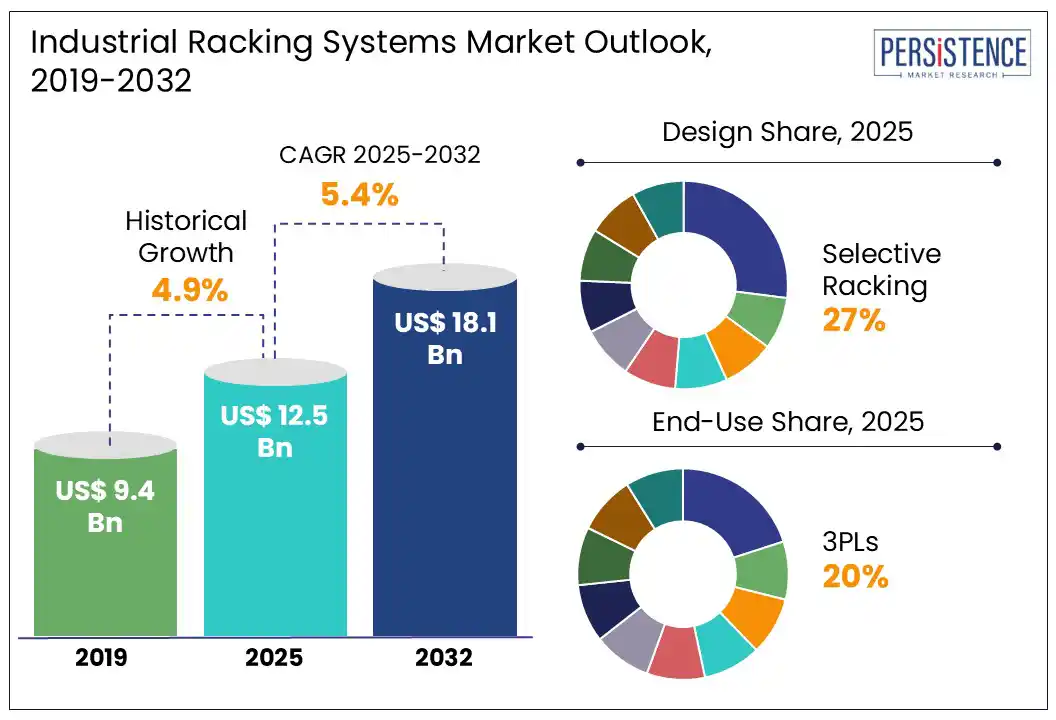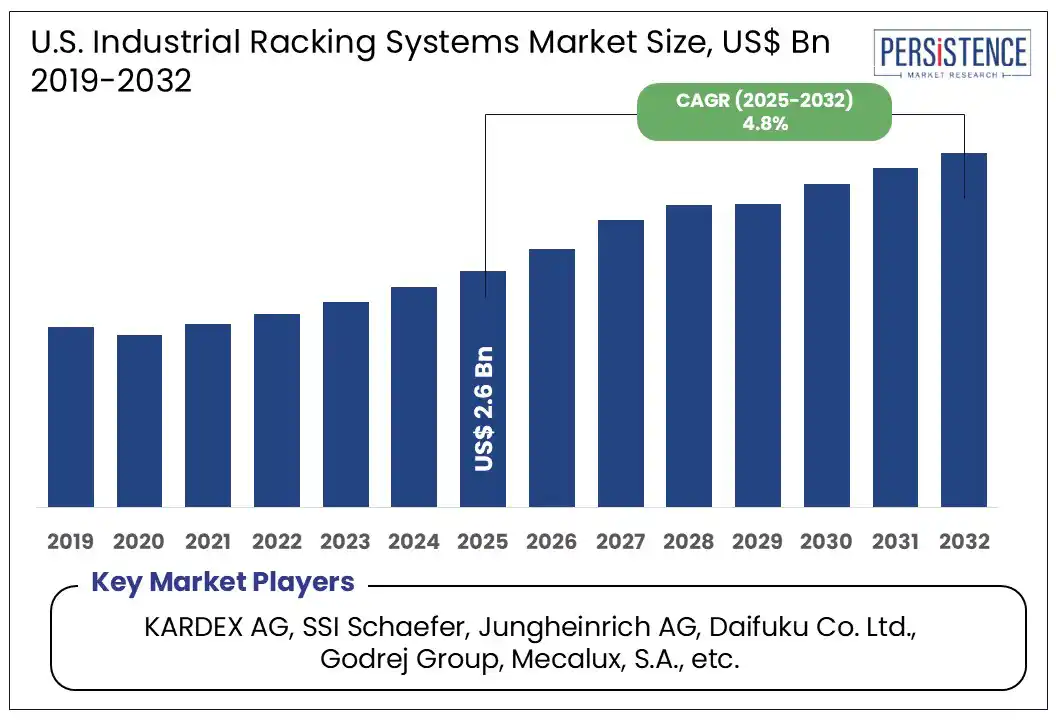ID: PMRREP18838| 189 Pages | 2 Jul 2025 | Format: PDF, Excel, PPT* | Industrial Automation

The global industrial racking system market size is expected to grow from US$12.5 Bn in 2025 to US$ 18.1 Bn by 2032. The market is projected to register a moderate CAGR of 5.4% during this period.
According to Persistence Market Research analysis, the global industrial racking systems market is largely driven by the growing investments in ecommerce and third-part logistics (3PLs) services among all major economies in the world. The need for advanced racking systems for handling high inventory turnover rates and maintaining resilience in complex supply chain networks is expected to push the market growth in coming years.

Key Highlights of the Industry
|
Market Attributes |
Key Insights |
|
Industrial Racking System Market Size (2025E) |
US$ 12.5 Bn |
|
Projected Market Value (2032F) |
US$ 18.1 Bn |
|
Global Market Growth Rate (CAGR 2025 to 2032) |
4.9% |
|
Historical Market Growth Rate (CAGR 2019 to 2023) |
5.4% |
North America industrial racking system market is estimated to hold a share of 29% in 2025. According to the U.S. Census Bureau, e-commerce retail sales in the U.S. reached US$ 300 Bn in first quarter of 2025 accounting for nearly 17% of the total retail sales. This widespread expansion of online retail increases the demand for high-density and automated racking systems to manage soaring inventory needs.
The adoption of automation technologies has further propelled market growth. Over 50% of warehouses in North America are estimated to implement automation solutions like automated storage and retrieval systems (ASRS) and robotics 2032.
Substantial investment in supply chain optimization has spurred demand for smart racking solutions that integrate with Warehouse Management Systems (WMS) and IoT-enabled inventory management tools. The region’s robust cold storage infrastructure also contributes to its dominance.
With the U.S. cold storage market valued at over US$ 35 billion in 2022, industries like food and beverage, pharmaceuticals, and chemicals are increasingly adopting temperature-controlled racking systems. Government incentives supporting sustainable practices in warehousing have encouraged the use of energy-efficient and recyclable racking systems.
Selective pallet racking systems are emerging as the leading product type with a share of 27% in 2025. These systems enable direct access to every pallet, making them ideal for warehouses with a diverse inventory and high SKU (Stock Keeping Unit) counts.
One of the key drivers of growth is the rapid expansion of the e-commerce sector, where selective racking is used extensively to ensure quick and efficient picking and replenishment of goods. Industries like food and beverage, retail, and pharmaceuticals prefer selective pallet racking for its compatibility with FIFO (First-In-First-Out) and LIFO (Last-In-First-Out) inventory management systems.
Selective pallet racking systems are also favored for their cost advantages compared to other high-density solutions, making them accessible to small and medium-sized enterprises. These racks are easy to install, customizable, and adaptable to automation technologies, increasing their utility in modern warehouses. Their balance of functionality, affordability, and adaptability ensures selective pallet racking remains the leading choice in the industrial racking system market.
Rack Supported Warehouses (RSWs) have emerged as a favoured solution in industrial settings, offering high-density storage and efficient vertical space utilization. Particularly relevant in regions like India and the Middle East & Africa (MEA), where land scarcity or cost is a concern, RSWs optimize storage within limited floor areas.
RSWs present a cost-effective alternative to traditional warehouses, significantly reducing the need for extensive horizontal space, a crucial advantage in high real estate cost markets. With RSWs, the vertical storage capability substantially boosts overall storage capacity, especially beneficial in densely populated areas with high storage demands. This adoption trend not only presents growth opportunities but aligns with market demands, emphasizing RSWs as pivotal for modern industrial storage solutions in India and the MEA region, combining space optimization, cost efficiency, customization, and technological advancements.
Potential growth in the global industrial racking system industry is predicted to be driven by its integration with AI, IoT, and advanced data analytics. These technologies are estimated to enable warehouses to optimize storage, effectively manage inventory, and enhance operational efficiency.
Around 80% of warehouses are projected to use AI-powered automation for inventory management by 2028, driving the demand for intelligent and scalable racking solutions. The continuous expansion of e-commerce coupled with the need for hyper-localized supply chains is expected to continue driving the demand for racking systems.
Green warehouses and energy efficient racking solutions are estimated to gain traction as business work toward reducing their carbon footprint. Around 60% of warehouse operators are planning to invest in sustainable technologies within the next five years.

The market showcased a CAGR of 4.9% during the historical period. The e-commerce sector witnessed explosive growth during the period, thereby driving the industrial racking system market growth. Continuous expansion resulted in a need for automated and high-density racking systems to enhance inventory management and order fulfillment.
In 2023, Amazon alone was reportedly operating more than 100 fulfillment centers in the U.S. and over 185 across the globe, several of which feature state-of-the-art racking and shelving systems integrated with automated technologies. Industry also witnessed significant advancements in automation and robotics, contributing to the rise of automated storage and retrieval systems. The sales of industrial racking system to record a CAGR of 5.4% during the forecast period from 2025 to 2032.
Automation and Smart Warehousing
Automation storage and retrieval systems (ASRS) are becoming vital in modern warehouses. Warehouse with automated systems are noted to achieve 30% more storage density compare to traditional warehouses. Automation assists in decreasing labour costs, minimizing errors, and lowering overhead b enabling 24/7 operation.
A survey found that 60% of warehouse operators expected automation to decrease their operating costs by 10% to 20%. Robust growth in e-commerce, especially with the rise of same-day and next-day delivery services, makes automation in warehousing crucial.
A study conducted revealed that 85% of companies with advanced automation reported a 155 reduction in fulfilment times. Automated racking systems and smart warehousing solutions offer scalability for companies along with great flexibility. Around 70% of warehouses with automated solutions expect to scale their operation within the next 5 years, with a high focus on optimizing for high throughput demands.
Increase in Third-party Logistics (3PL) Providers
3PL providers are increasing their reliance on advanced racking systems to optimize warehouse space and improve operational efficiency. DHL reported that e-commerce is predicted to account for 50% of the global logistics revenues by 2025, thereby emphasizing the rising reliance on 3PL providers in retail and consumer goods sectors.
Sustainability is a key focus for 3PL provides with a focus on decreasing their environmental footprint through eco-friendly technologies and practices. This includes the adoption of energy-efficient racking systems, green warehouses, and electric vehicles for transportation.
Green logistics is estimated to represent more than US$ 3.5 trillion of the logistics market by the end of 2032 as businesses and logistics providers aim to meet stringent environmental regulations.
Maintenance and Operational Costs
Maintenance and operational costs are crucial considerations in the adoption and long-term use of industrial racking systems. Routine maintenance includes schedules inspections, cleaning, lubrication of mechanical parts, and adjustments to ensure the proper functioning of racking systems.
According to a report by United States Department of Transportation - Federal Highway Administration, the warehousing cost accounts for 26% of the total inventory carrying cost in the United States. The share is even higher in many of the emerging parts of the world.
Repair costs for racking systems can vary widely depending on the extent of the damage and whether or not a component need replacement. Typically, companies in industries like warehousing and distribution spend an average of 1% to 3% of their total revenue on maintenance-related activities annually.
Integration with Warehouse Management Systems
Warehouse management systems (WMS) assist businesses to manage and optimize day-to-day warehouse operation. Integration with WMS is a prominent factor driving the adoption of ASRS, robotic picking, and other automate systems in warehouses. Around 70% of warehouse operators are planning to invest in automation technologies in the next two years, with integration with WMS being one of the primary objectives.
Approximately 80% of warehouse operators reported that integrating WMS with automation technologies has boosted productivity by at least 25%. A key benefit of integrating WMS with automated racking systems is the ability to track inventory in real time. Over 62% of warehouse operators have implemented to plan to implement RFID-based inventory management systems in the next two years.
Integration of WMS with racking systems decreases human error in order picking, packing, and shipping, resulting in increased order accuracy and faster fulfilment times. Companies that have implemented WMS and automation technologies reported a 30% reduction in order picking errors and 20% decrease in fulfilment times.
Cold Storage and Temperature-controlled Solutions
The pharmaceutical industry is one of the largest consumers of cold storage solutions, especially with the growing importance of vaccines, biologics, and blood products that need stringent temperature control to maintain efficacy. Rapid growth of e-commerce coupled with the rising demand for fast delivery of fresh and frozen goods is driving the expansion of cold-storage facilities, especially for last mile delivery.
About 52% of companies in the food and beverage industry are planning to invest in automated cold storage and temperature-controlled warehouses to meet the increasing demand from online shoppers. Cold storage solutions assist in extending the shelf life of perishable products, thereby decreasing waste and ensuring products retain their freshness and quality. Rise in consumer preference for fresh, organic, and sustainably produced foods is estimated to drive the demand for cold storage.
Companies in the industrial racking system market are focusing on continuous product innovation to develop racking systems with improveed functionality like modular, automated, or adjustable racking systems. They are progressively investing in research and development activities to offer solutions that maximise space utilization, enhance safety, and improve operational efficiency.
Simultaneously, there is a focus on expanding product portfolios to encompass various racking solutions, such as pallet racking, cantilever racking, drive-in/drive-through racking, and mezzanine flooring, tailored to specific industry demands. Offering more customizable and modular racking systems adds flexibility in design, enabling adaptation to diverse warehouse layouts and addressing a range of industry requirements.
Recent Industry Developments
The market is anticipated to reach a value of US$ 9.7 Bn by 2032.
They are structures made from different materials that are designed to support goods in a warehouse or industrial facility.
Racking systems are grouped in three major product types such as drive-in pallet, push-back pallet, and selective pallet.
North America is predicted to emerge as the leading region in the industry with a share of 29% in 2024.
A few of the key players operating in the market are Kardex AG, Daifuku Co., Ltd., SSI Schaefer, and Foothills Systems.
|
Attributes |
Details |
|
Forecast Period |
2025 to 2032 |
|
Historical Data Available for |
2019 to 2024 |
|
Market Analysis |
Value: US$ Billion, Volume: Aa Applicable |
|
Key Regions Covered |
|
|
Key Market Segments Covered |
|
|
Key Companies Profiled in the Report |
. |
|
Report Coverage |
|
|
Customization and Pricing |
Available upon request |
By Design
By Carrying Capacity
By Ownership
By End-Use
By Region
Delivery Timelines
For more information on this report and its delivery timelines please get in touch with our sales team.
About Author